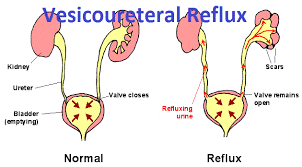VUR(Vesicoureteral reflux) Ayurveda View Of Infant And Adult!
Vesicoureteral reflux is a condition in which urine flows in the wrong direction, from the bladder back into the ureter. It is most common in infants and young children, but it can affect older children and adults, too
Urine is waste matter. Urine normally flows in one direction—down from the kidneys, through tubes called ureters, to the bladder. Vesicoureteral reflux (VUR) is the abnormal flow of urine from the bladder back into the ureters.
VUR is most commonly diagnosed in infancy and childhood after the patient has a urinary tract infection (UTI). About one-third of children with UTI are found to have VUR. VUR can lead to infection because urine that remains in the child's urinary tract provides a place for bacteria to grow. But sometimes the infection itself is the cause of VUR.
There are two types of VUR. Primary VUR occurs when a child is born with an impaired valve where the ureter joins the bladder. This happens if the ureter did not grow long enough during the child's development in the womb. The valve does not close properly, so urine backs up (refluxes) from the bladder to the ureters, and eventually to the kidneys. This type of VUR can get better or disappear as the child gets older. The ureter gets longer as the child grows, and the function of the valve improves.
Secondary VUR occurs when there is a blockage anywhere in the urinary system. The blockage may be caused by an infection in the bladder that leads to swelling of the ureter. This also causes a reflux of urine to the kidneys.
Infection is the most common symptom of VUR. As the child gets older, other symptoms, such as bedwetting, high blood pressure, protein in the urine, and kidney failure, may appear.
Common tests to show the presence of urinary tract infection include urine tests and cultures.
The medical plan of treatment will vary according to your child’s age, number of urinary tract infections and X-ray findings. Reflux is " graded " on a scale of one through five: one is the mildest and five is the most severe. In children with mild to moderate grades of reflux (grades 1-3) there is an excellent chance that the reflux will disappear as your child gets older. Treatment is aimed at preventing urinary tract infections when reflux and urinary tract infection are both present. The goal for treatment of VUR is to prevent any kidney damage from occurring.
Children With Grade 1-3 Reflux:
Most children have a good chance of outgrowing this condition as the ureteral valve matures.
* Take low dose of an antibiotic nightly for as long
as the child has reflux.
* Have urine cultures done on a regular basis.
* Undergo VCUG every 12-18 months to check if reflux
has disappeared.
* Have a sonogram of the kidneys to check for growth
every 1-2 years.
Children With Grades 4-5 Reflux Or UTI’s While On Antibiotic Medication:
* Have Surgery to correct the reflux. This type of
surgery is highly successful and safe.
Signs and symptoms of a bladder infection or a UTI may be:
- urgency to urinate
- a burning sensation or pain when urinating
- blood in the urine
- cloudy urine
- urine with a strong, unpleasant smell
- dribbling urine, incontinence, and bed-wetting
- fever and abdominal pain
- fussiness
These may be less noticeable in infants.
Signs of a kidney infection are:
Long-term symptoms, if VUR is not treated, include:
- a palpable abdominal mass, caused by a swollen kidney
- poor weight gain
- hypertension, or high blood pressure
- kidney failure
- protein in the urine
- scarring of kidney tissue
An infant may have vomiting, diarrhea, lethargy, and may not be growing normally.
In Ayurveda at 3rd grade we treat sucessfully by medicines



+1.svg)
